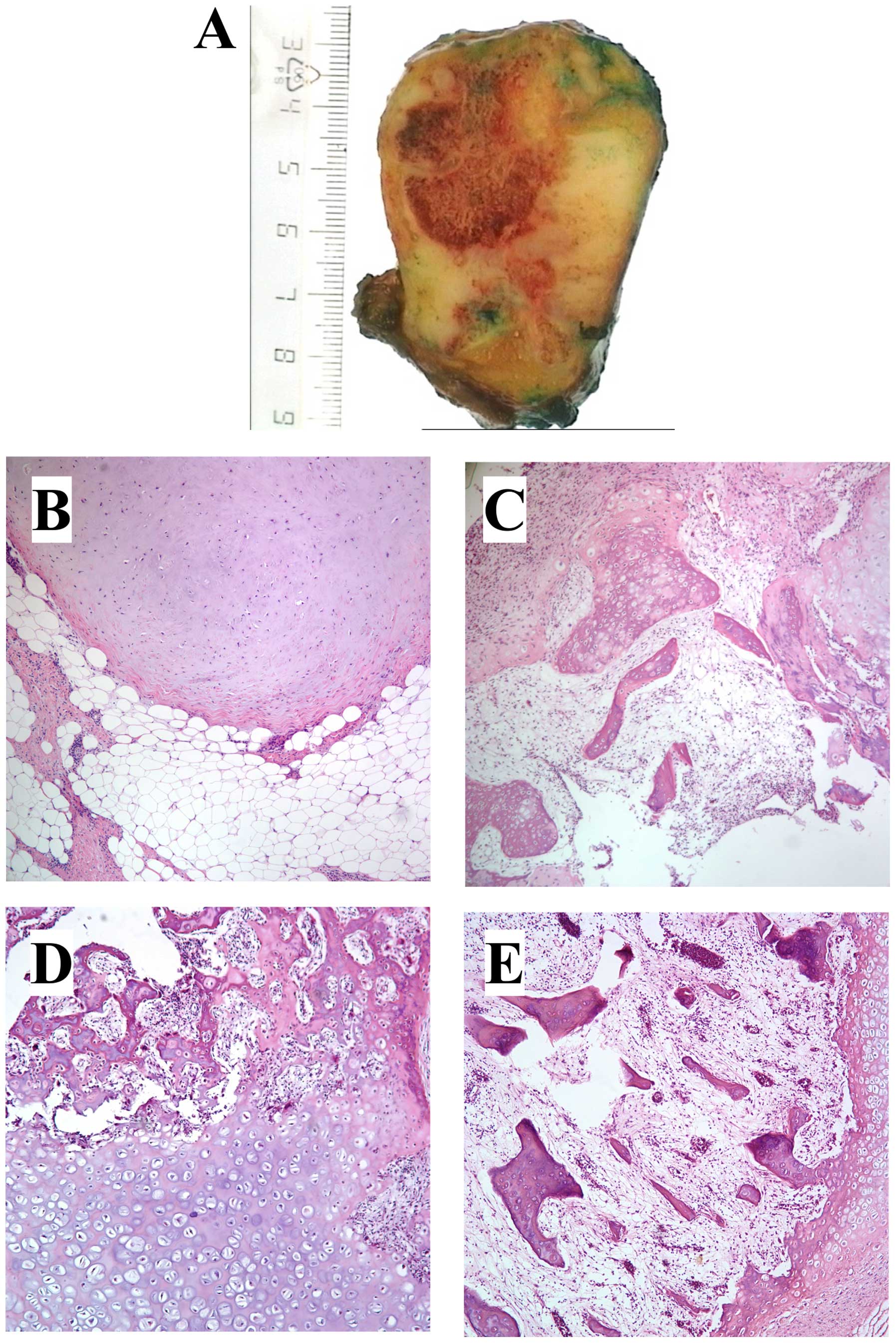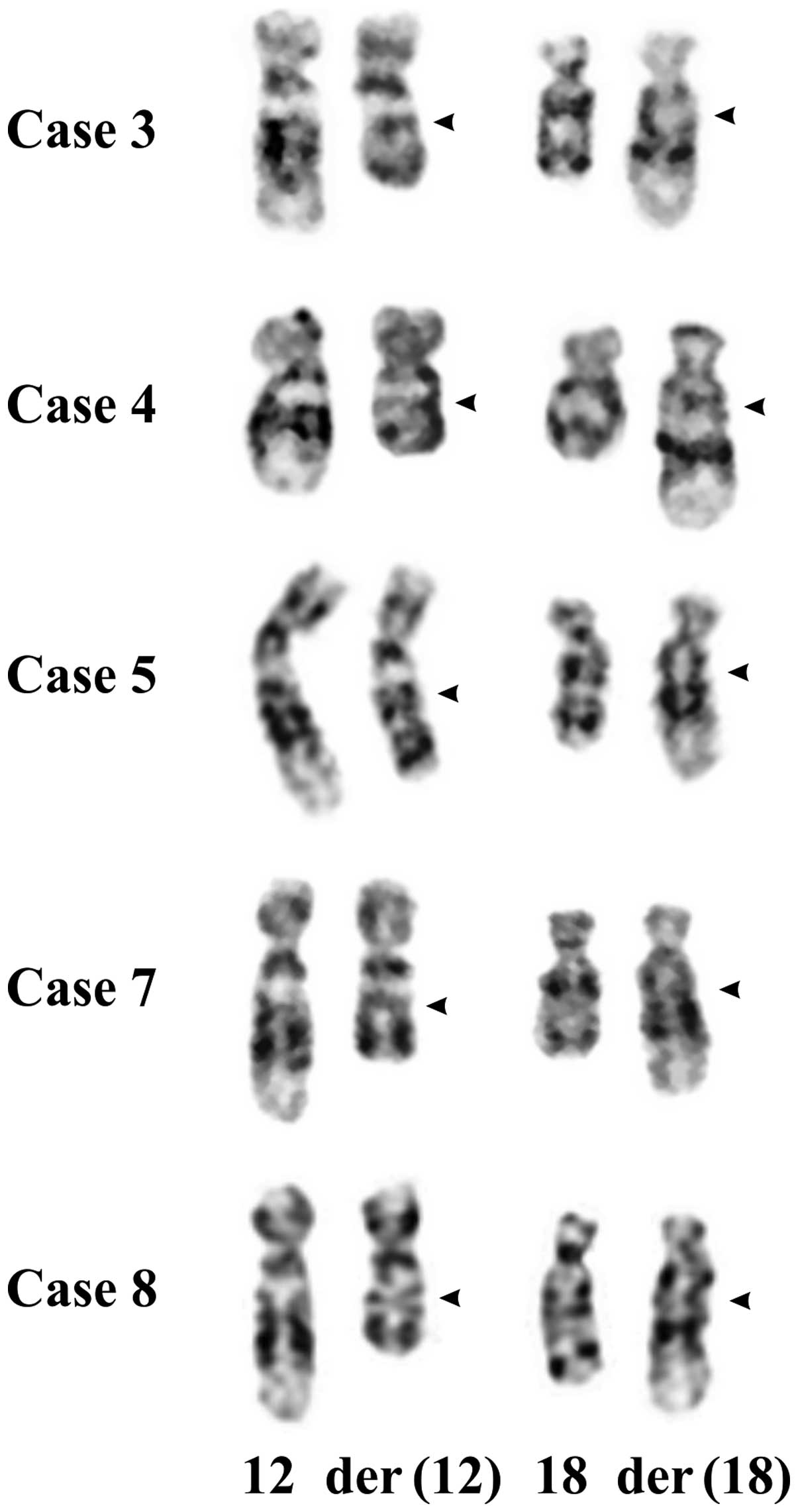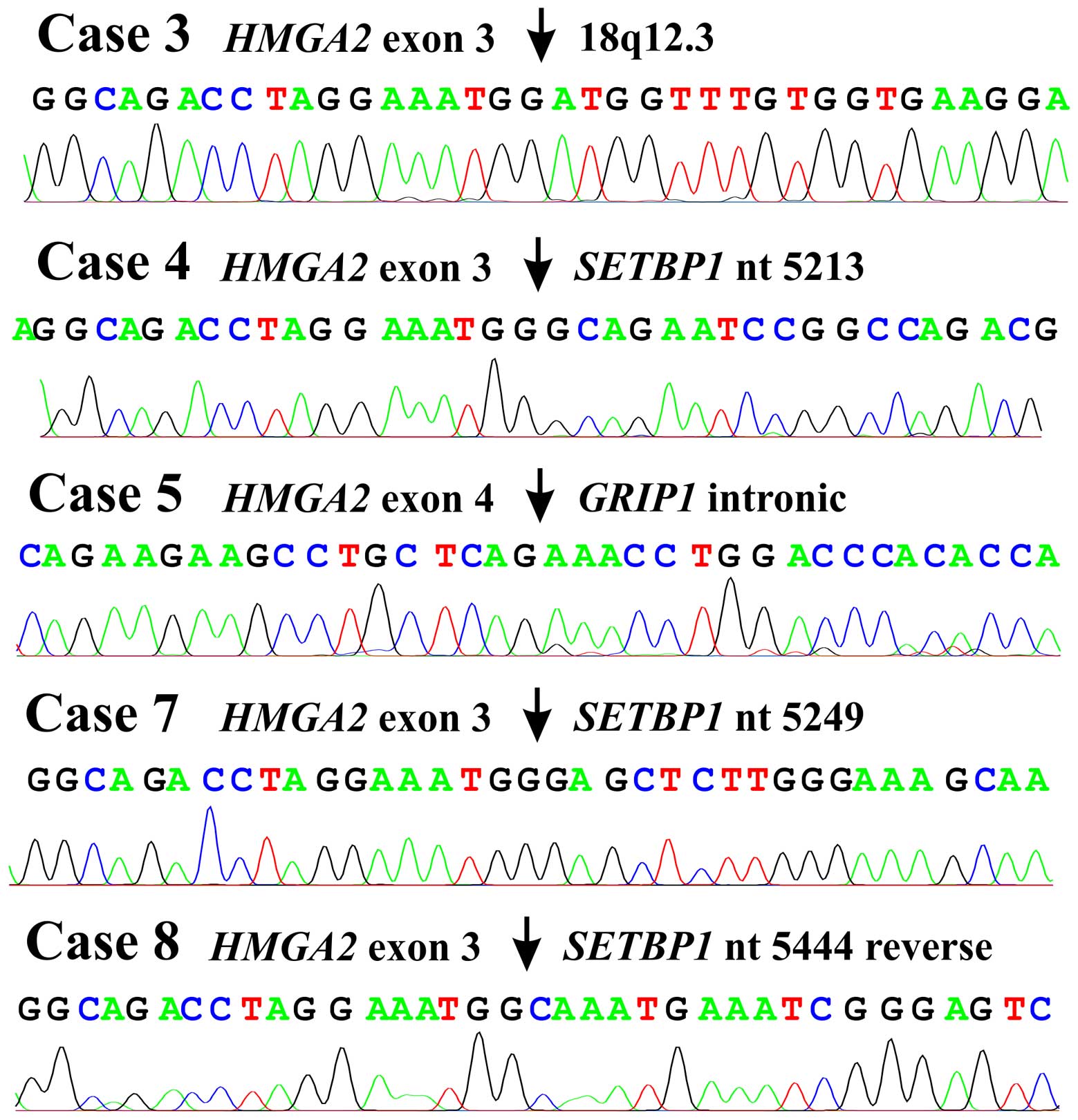|
1
|
Fletcher CDM, Bridge JA, Hogendoorn PCW
and Mertens F: WHO Classification of Tumours of Soft Tissue and
Bone. 4th edition. IARC Press; Lyon: 2013
|
|
2
|
Heim S, Mandahl N, Kristoffersson U,
Mitelman F, Rööser B, Rydholm A and Willén H: Reciprocal
translocation t(3;12) (q27;q13) in lipoma. Cancer Genet Cytogenet.
23:301–304. 1986. View Article : Google Scholar : PubMed/NCBI
|
|
3
|
Turc-Carel C, Dal Cin P, Rao U, Karakousis
C and Sandberg AA: Cytogenetic studies of adipose tissue tumors. I.
A benign lipoma with reciprocal translocation t(3;12)(q28;q14).
Cancer Genet Cytogenet. 23:283–289. 1986. View Article : Google Scholar : PubMed/NCBI
|
|
4
|
Bartuma H, Hallor KH, Panagopoulos I,
Collin A, Rydholm A, Gustafson P, Bauer HC, Brosjö O, Domanski HA,
Mandahl N, et al: Assessment of the clinical and molecular impact
of different cytogenetic subgroups in a series of 272 lipomas with
abnormal karyotype. Genes Chromosomes Cancer. 46:594–606. 2007.
View Article : Google Scholar : PubMed/NCBI
|
|
5
|
Petit MM, Mols R, Schoenmakers EF, Mandahl
N and Van de Ven WJ: LPP, the preferred fusion partner gene of
HMGIC in lipomas, is a novel member of the LIM protein gene family.
Genomics. 36:118–129. 1996. View Article : Google Scholar : PubMed/NCBI
|
|
6
|
Schoenmakers EF, Wanschura S, Mols R,
Bullerdiek J, Van den Berghe H and Van de Ven WJ: Recurrent
rearrangements in the high mobility group protein gene, HMGI-C, in
benign mesenchymal tumours. Nat Genet. 10:436–444. 1995. View Article : Google Scholar : PubMed/NCBI
|
|
7
|
Bianchini L, Birtwisle L, Saâda E, Bazin
A, Long E, Roussel JF, Michiels JF, Forest F, Dani C, Myklebost O,
et al: Identification of PPAP2B as a novel recurrent translocation
partner gene of HMGA2 in lipomas. Genes Chromosomes Cancer.
52:580–590. 2013. View Article : Google Scholar : PubMed/NCBI
|
|
8
|
Broberg K, Zhang M, Strömbeck B, Isaksson
M, Nilsson M, Mertens F, Mandahl N and Panagopoulos I: Fusion of
RDC1 with HMGA2 in lipomas as the result of chromosome aberrations
involving 2q35–37 and 12q13–15. Int J Oncol. 21:321–326.
2002.PubMed/NCBI
|
|
9
|
Nilsson M, Mertens F, Höglund M, Mandahl N
and Panagopoulos I: Truncation and fusion of HMGA2 in lipomas with
rearrangements of 5q32→q33 and 12q14→q15. Cytogenet Genome Res.
112:60–66. 2006. View Article : Google Scholar
|
|
10
|
Nilsson M, Panagopoulos I, Mertens F and
Mandahl N: Fusion of the HMGA2 and NFIB genes in lipoma. Virchows
Arch. 447:855–858. 2005. View Article : Google Scholar
|
|
11
|
Petit MM, Schoenmakers EF, Huysmans C,
Geurts JM, Mandahl N and Van de Ven WJ: LHFP, a novel translocation
partner gene of HMGIC in a lipoma, is a member of a new family of
LHFP-like genes. Genomics. 57:438–441. 1999. View Article : Google Scholar : PubMed/NCBI
|
|
12
|
Mandahl N: Methods in solid tumour
cytogenetics. Human Cytogenetics: Malignancy and Acquired
Abnormalities. Rooney DE: Oxford University Press; New York: pp.
165–203. 2001
|
|
13
|
Schaffer LG, Slovak ML and Campbell LJ:
ISCN 2009: An International System for Human Cytogenetic
Nomenclature. Karger; Basel: 2009
|
|
14
|
Heim S and Mitelman F: Cancer
Cytogenetics. 3rd Edition. Wiley-Blackwell; New York, NY: 2009
|
|
15
|
Cleynen I and Van de Ven WJ: The HMGA
proteins: A myriad of functions (Review). Int J Oncol. 32:289–305.
2008.PubMed/NCBI
|
|
16
|
Fedele M, Berlingieri MT, Scala S,
Chiariotti L, Viglietto G, Rippel V, Bullerdiek J, Santoro M and
Fusco A: Truncated and chimeric HMGI-C genes induce neoplastic
transformation of NIH3T3 murine fibroblasts. Oncogene. 17:413–418.
1998. View Article : Google Scholar : PubMed/NCBI
|
|
17
|
Arlotta P, Tai AK, Manfioletti G, Clifford
C, Jay G and Ono SJ: Transgenic mice expressing a truncated form of
the high mobility group I-C protein develop adiposity and an
abnormally high prevalence of lipomas. J Biol Chem.
275:14394–14400. 2000. View Article : Google Scholar : PubMed/NCBI
|
|
18
|
Battista S, Fidanza V, Fedele M,
Klein-Szanto AJ, Outwater E, Brunner H, Santoro M, Croce CM and
Fusco A: The expression of a truncated HMGI-C gene induces
gigantism associated with lipomatosis. Cancer Res. 59:4793–4797.
1999.PubMed/NCBI
|
|
19
|
Bartuma H, Panagopoulos I, Collin A,
Trombetta D, Domanski HA, Mandahl N and Mertens F: Expression
levels of HMGA2 in adipocytic tumors correlate with morphologic and
cytogenetic subgroups. Mol Cancer. 8:362009. View Article : Google Scholar : PubMed/NCBI
|
|
20
|
Quade BJ, Weremowicz S, Neskey DM, Vanni
R, Ladd C, Dal Cin P and Morton CC: Fusion transcripts involving
HMGA2 are not a common molecular mechanism in uterine leiomyomata
with rearrangements in 12q15. Cancer Res. 63:1351–1358.
2003.PubMed/NCBI
|
|
21
|
Minakuchi M, Kakazu N, Gorrin-Rivas MJ,
Abe T, Copeland TD, Ueda K and Adachi Y: Identification and
characterization of SEB, a novel protein that binds to the acute
undifferentiated leukemia-associated protein SET. Eur J Biochem.
268:1340–1351. 2001. View Article : Google Scholar : PubMed/NCBI
|
|
22
|
Hoischen A, van Bon BW, Gilissen C, Arts
P, van Lier B, Steehouwer M, de Vries P, de Reuver R, Wieskamp N,
Mortier G, et al: De novo mutations of SETBP1 cause
Schinzel-Giedion syndrome. Nat Genet. 42:483–485. 2010. View Article : Google Scholar : PubMed/NCBI
|
|
23
|
Cristóbal I, Blanco FJ, Garcia-Orti L,
Marcotegui N, Vicente C, Rifon J, Novo FJ, Bandres E, Calasanz MJ,
Bernabeu C, et al: SETBP1 overexpression is a novel leukemogenic
mechanism that predicts adverse outcome in elderly patients with
acute myeloid leukemia. Blood. 115:615–625. 2010. View Article : Google Scholar
|
|
24
|
Panagopoulos I, Kerndrup G, Carlsen N,
Strömbeck B, Isaksson M and Johansson B: Fusion of NUP98 and the
SET binding protein 1 (SETBP1) gene in a paediatric acute T cell
lymphoblastic leukaemia with t(11;18)(p15;q12). Br J Haematol.
136:294–296. 2007. View Article : Google Scholar : PubMed/NCBI
|
|
25
|
Trimarchi T, Ntziachristos P and Aifantis
I: A new player SETs in myeloid malignancy. Nat Genet. 45:846–847.
2013. View
Article : Google Scholar : PubMed/NCBI
|
|
26
|
Matoulkova E, Michalova E, Vojtesek B and
Hrstka R: The role of the 3′ untranslated region in
post-transcriptional regulation of protein expression in mammalian
cells. RNA Biol. 9:563–576. 2012. View Article : Google Scholar : PubMed/NCBI
|
|
27
|
Ahmadi SA, van Landeghem FK, Blechschmidt
C, Lieber K, Haberl EJ and Thomale UW: Intratentorial
osteochondrolipoma in a 9-year-old boy. J Neurosurg Pediatr.
3:386–391. 2009. View Article : Google Scholar : PubMed/NCBI
|
|
28
|
Gru AA and Santa Cruz DJ:
Osteochondrolipoma: A subcutaneous lipoma with chondroid and bone
differentiation of the chest wall. J Cutan Pathol. 39:461–463.
2012. View Article : Google Scholar : PubMed/NCBI
|
|
29
|
Gültekin SE, Kahraman S and Karadayı K:
Parosteal osteochondrolıpoma of the mandıble. J Oral Maxillofac
Pathol. 16:280–282. 2012. View Article : Google Scholar
|
|
30
|
Nishio J, Ideta S, Iwasaki H and Naito M:
Scapular osteochondrolipoma: Imaging features with pathological
correlation. Oncol Lett. 6:817–820. 2013.PubMed/NCBI
|
|
31
|
Rau T, Soeder S, Olk A and Aigner T:
Parosteal lipoma of the thigh with cartilaginous and osseous
differentiation: An osteochondrolipoma. Ann Diagn Pathol.
10:279–282. 2006. View Article : Google Scholar : PubMed/NCBI
|
|
32
|
Soulard R, Nguyen AT, Souraud JB, Oddon
PA, Fouet B and Cathelinaud O: Osteochondrolipoma of the
submandibular region: A case report and review of the literature.
Head Neck Pathol. 6:486–491. 2012. View Article : Google Scholar : PubMed/NCBI
|
|
33
|
Lin TM, Chang HW, Wang KH, Kao AP, Chang
CC, Wen CH, Lai CS and Lin SD: Isolation and identification of
mesenchymal stem cells from human lipoma tissue. Biochem Biophys
Res Commun. 361:883–889. 2007. View Article : Google Scholar : PubMed/NCBI
|
|
34
|
Fritchie KJ, Renner JB, Rao KW and Esther
RJ: Osteolipoma: Radiological, pathological, and cytogenetic
analysis of three cases. Skeletal Radiol. 41:237–244. 2012.
View Article : Google Scholar
|


















